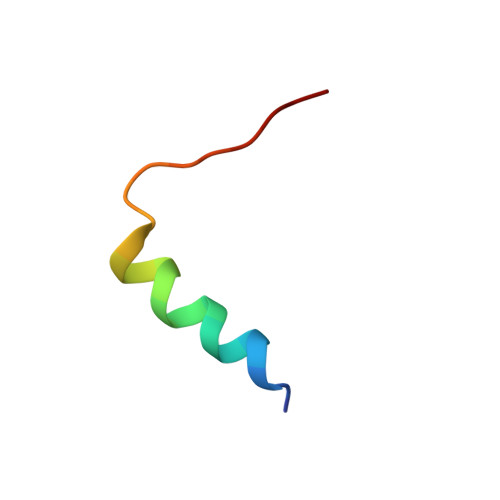Release of immunomodulatory peptides at bacterial membrane interfaces as a novel strategy to fight microorganisms.
Viana de Freitas, T., Karmakar, U., Vasconcelos, A.G., Santos, M.A., Oliveira do Vale Lira, B., Costa, S.R., Barbosa, E.A., Cardozo-Fh, J., Correa, R., Ribeiro, D.J.S., Prates, M.V., Magalhaes, K.G., Soller Ramada, M.H., Roberto de Souza Almeida Leite, J., Bloch Jr., C., Lima de Oliveira, A., Vendrell, M., Brand, G.D.(2023) J Biol Chem 299: 103056-103056
- PubMed: 36822328
- DOI: https://doi.org/10.1016/j.jbc.2023.103056
- Primary Citation of Related Structures:
8EB1 - PubMed Abstract:
Cationic and amphiphilic peptides can be used as homing devices to accumulate conjugated antibiotics to bacteria-enriched sites and promote efficient microbial killing. However, just as important as tackling bacterial infections, is the modulation of the immune response in this complex microenvironment. In the present report, we designed a peptide chimaera called Chim2, formed by a membrane-active module, an enzyme hydrolysis site and a formyl peptide receptor 2 (FPR2) agonist. This molecule was designed to adsorb onto bacterial membranes, promote their lysis, and upon hydrolysis by local enzymes, release the FPR2 agonist sequence for activation and recruitment of immune cells. We synthesized the isolated peptide modules of Chim2 and characterized their biological activities independently and as a single polypeptide chain. We conducted antimicrobial assays, along with other tests aiming at the analyses of the cellular and immunological responses. In addition, assays using vesicles as models of eukaryotic and prokaryotic membranes were conducted and solution structures of Chim2 were generated by 1 H NMR. Chim2 is antimicrobial, adsorbs preferentially to negatively charged vesicles while adopting an α-helix structure and exposes its disorganized tail to the solvent, which facilitates hydrolysis by tryptase-like enzymes, allowing the release of the FPR2 agonist fragment. This fragment was shown to induce accumulation of the cellular activation marker, lipid bodies, in mouse macrophages and the release of immunomodulatory interleukins. In conclusion, these data demonstrate that peptides with antimicrobial and immunomodulatory activities can be considered for further development as drugs.
Organizational Affiliation:
Universidade de Brasília, Instituto de Química, Laboratório de Síntese e Análise de Biomoléculas, LSAB, Brasília, Distrito Federal, Brasil.














